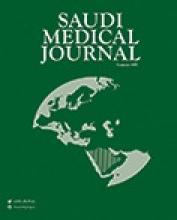To the Editor
Al-Amad nicely studied the seroprevalence and case characteristics of hepatitis B, C, and human immunodeficiency virus (HIV) and their transmissibility from patients to dental personnel following percutaneous and mucocutaneous injuries in a teaching dental hospital in Sharjah, United Arab Emirates (UAE).1 The author found that among reported incidents, 3.8% of patients had antibodies against hepatitis C virus, 2.2% were positive for hepatitis B surface antigens, and there were no positive cases for HIV.1 The author delineated that the majority of studied patients attending that dental center were in low-income professions, who have been granted residency visas and work permits despite positive HBV and/or HCV screening results, which explained higher prevalence. However, the immediate deportation of HIV- positive cases explained their non-existence among the studied cohort.1 Despite that explanation, I still presume that the actual HIV seroprevalence was underestimated in the studied population. My presumption is based on the following 2 points.
First, it is obvious that HIV infection is globally an important health threat, particularly in developing countries. Though no recent data are yet available on the exact HIV seroprevalence in UAE, the available data showed that since the 1980s – when the first HIV case was reported in UAE – till the end of 2012, 780 HIV patients were reported among UAE national citizens. Most of them was documented in the Sharjah and Dubai emirates reflecting probably higher rates of risk-taken behaviors in these 2 emirates. However, the aforementioned reported numbers constituted only those who were officially registered during screening blood donors, pregnant, patients with tuberculosis, and premarital testing. Those who were suspected to have HIV exposure e.g through sexual contacts or drug injections might escape HIV screening. Accordingly, most at risk groups might be underrepresented in the aforementioned data.2
Second, HIV transmissibility from patients to dental personnel could further accentuate the actual HIV seroprevalence in UAE by the following 2 factors. 1) Assessing dental students’ knowledge in UAE on transmission and oral manifestations of HIV/AIDS and their attitudes towards patients regarding obligations to treat showed noticeable misconceptions and negative attitudes.3 2) Interestingly, one third of dentists from 3 Arab dental schools, including UAE indicated they would refuse to treat HIV- positive patients. Knowledge of body fluids transmitting HIV and moral beliefs were associated with lower odds of refusing to treat HIV- positive patients (OR=0.86 and 0.38).4
Reply from the Author
Al-Mendalawi presumes that the prevalence of HIV in this study1 is under-reported based on the Global AIDS Response Progress Report 2014,2 and 2 surveys assessing HIV knowledge and attitude among dental students and dental professionals. Unfortunately, both references are not relevant for the reasons stated below.
My paper1 clearly describes the sample as low-income expatriates who would rely on the free dental care that is provided by a teaching dental hospital. Data from the Global AIDS Response Progress Report of 20142 discusses HIV data that is exclusive to UAE nationals, and hence is incomparable to the data presented in my paper.1 In fact, the data presented in my paper1 are a better reflection of the prevalence of HIV, HCV and HBV in the UAE because it covered the country’s diverse and multinational composition. The presumption made by Professor Al-Mendalawi that poor HIV knowledge among dental personnel is a factor that would influence HIV prevalence is irrational. Professor Al-Mendalawi should know that the only source of data in my study is sharp and splash injuries which were completely unanticipated. Dental personnel’s HIV knowledge and attitudes would therefore have absolutely no effect on the prevalence of this virus.
Suhail H. Al-Amad,
College of Dental Medicine, University of Sharjah, Sharjah, United Arab Emirates ORCID ID: orcid.org/0000-0001-8872-4887
- Copyright: © Saudi Medical Journal
This is an open-access article distributed under the terms of the Creative Commons Attribution-Noncommercial-Share Alike 3.0 Unported, which permits unrestricted use, distribution, and reproduction in any medium, provided the original work is properly cited.






